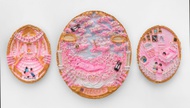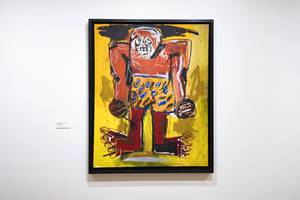Black ink pools onto cream-colored paper forming an orchid, petals unfolding. At its center, the flower wilts, resembling a seated woman, her head tilted downward. The image is abstract but striking, and the message behind it all the more poignant.
Commissioned by the Rogers Foundation, 30 linocut prints of the flower were made by Las Vegas-based artist Lance Smith, “with the unjust murders of our trans sisters heavy on my heart,” Smith explained in a June 10 Facebook post.
The artist was also influenced by the Steve Wonder song “Black Orchid,” which Smiths says “really speaks to the idea of a black trans woman being misunderstood and vilified.” “I know that’s probably not what he meant it for, but that song kind of encapsulates a lot of the experiences—not all, because they’re not a monolith—of many black trans women who are being murdered.”
At least 10 black trans women have been murdered in the United States this year, according to the Human Rights Campaign. In April, Muhlaysia Booker, 23, survived a mob attack in Dallas, only to be shot dead in an unrelated incident a month later. Another Dallas trans woman, Chynal Lindsey, 26, was found murdered on June 1.
According to GLAAD, the life expectancy of black trans women in the United States is 35. As a result, Smith’s current work subversively spotlights the violence and injustice that trans women of color face.
“Every day when I’m in a space, I’m trying to figure out ways to open the back door [for others with less access],” Smith says. “This is my way of trying to help.”
The prints were presented as gifts at a Rogers Art Loft event, but Smith plans to create another run of linocuts benefitting a trans nonprofit.
As a black queer artist, Smith’s past works have explored the human experience as it relates to memory, moral apathy and queerness. Recently, Smith spent four weeks in Puebla, Mexico, for a residency, which also influenced the linocuts. “Some people consider me non-binary because I present in different ways, but I’m very aware of our trans brothers and sisters whose lives depend on them being able to fit into the binary,” Smith says. “When I was in Puebla, if I put on an earring? [People referred to me with] all female pronouns. ... I was like, ‘I don’t want to get used to this. When I get to the States it’s not going to be like that.’ They’re always looking. It’s like a fine-tooth comb, combing through you visually. They want to know: Man or woman? Gay or straight?”
Ultimately, Smith’s experience yields a uniquely empathic perspective, one that bridges gaps at a time when we need it most. “As someone who has the privilege to straddle the in-between, I’m extremely aware,” Smith says. “I try to use it as a tool.”







